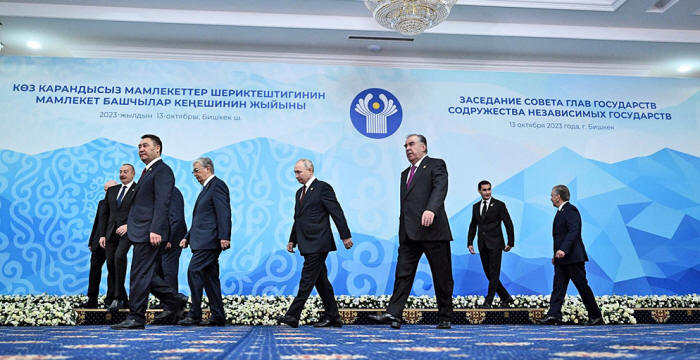|
by Timofey Bordachev Programme Director of the Valdai Club December 29, 2023 from ValdaiDiscussionClub Website translation by the RT Team January 03, 2024 from RT Website
Ethiopian Prime Minister Abiy Ahmed, Indonesian President Joko Widodo and Kazakhstan President Kassym-Jomart Tokayev head to a group photo session at the third Belt and Road Forum on October 18, 2023 in Beijing, China. © Getty Images / Getty Images
to fuel conflict in Europe, but states further east aren't as willing to play Washington's game...
The military and political conflict between Russia and the West, as well as the gradually accelerating confrontation between China and the US, determine the central position of Greater Eurasia and Asia in international politics.
This is, first and foremost, because this vast region is a space where stability and development are important for Moscow and Beijing, while crises and conflicts are highly desirable for the United States and its European satellites.
The year 2023 has shown that Greater Eurasia and
Asia have so far been resistant to the negative external influences
that are having the most dramatic consequences in Europe and Middle
East.
At the same time, as the major events of regional life in 2023 have shown, Asia and Eurasia are not free of certain internal contradictions, the resolution of which is an important task for interstate cooperation.
Among these contradictions, the relatively difficult relations between the world's two demographic giants - India and China - are at the top of the list.
Despite the fact that New Delhi and Beijing are
highly capable of not taking their conflict to the stage of systemic
confrontation, the existence of a border problem plays a significant
role in regional cooperation in general.
At the same time, India's objective search for a way to increase its joint force capabilities is conducive to its positive dialogue with the US and the West.
This, of course, worries Russia and China somewhat, but it has not become an obstacle to cooperation within the BRICS and the Shanghai Cooperation Organization (SCO).
Moreover,
The Asian part of the macro-region is negatively affected by the growing confrontation between China and the US.
Under these circumstances, some Asian states may indeed be concerned that Beijing sees them as the territorial base of its main global adversary or as a source of its own capabilities.
This is already leading to complex internal processes in such successful associations as ASEAN, as well as creating interest in some countries to intensify cooperation with the US, as the Philippines is doing, for example.
At the same time, we see that Asian countries are tending to raise the bar of their demands in their dialogue with Washington, which is experiencing a new bout of "pact-o-mania".
But they do not want to become satellites of the US or its new "unsinkable aircraft carriers."
The only exception is the island of Taiwan,
where nationalist sentiments are a pillar for maintaining the
American presence and blackmailing mainland China.
There are serious reasons to believe that this area will be used by Russia's and China's adversaries to create additional security problems for them.
So far, with the exception of Kazakhstan, all the Central Asian countries have demonstrated the ability of their national authorities to deal confidently with the problems that have arisen in the course of their political and economic development.
In the case of Kazakhstan, the events of January 2022 showed how fragile its statehood is and how easily it can be threatened by structural problems of an economic and political nature.
Uzbekistan, Tajikistan, and Kyrgyzstan, on the
other hand, demonstrate either a confident statehood or a consistent
move towards being less vulnerable to external challenges and
threats.
We know that the current institutions of international cooperation in Asia and Eurasia were created within the framework of an international order that is now changing and is becoming, in many of its dimensions, a legacy of history.
The same is true of the major conflicts in which regional powers are engaged in a colossal space whose main characteristic is the absence of clear dividing lines.
However, the institutions in Eurasia may also
prove more immune to the systemic problems that this form of
state-to-state relations faces against the backdrop of a significant
decline in the West's organizational capacity and its shift towards
a purely selfish model of behavior in international affairs.
Localizing the negative consequences of this will
be the main task of international cooperation in Asia and Eurasia in
the coming years.
|



